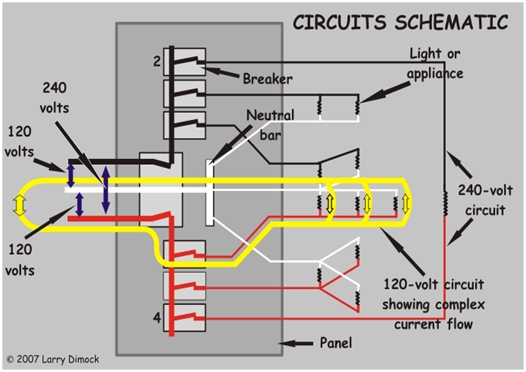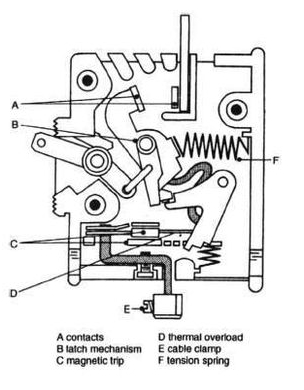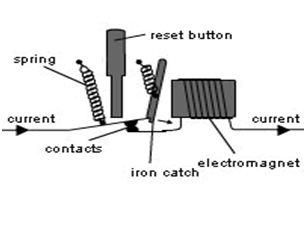Home › Electrical Engineering Forum › General Discussion › How does a Circuit Breaker work?
- This topic has 9 replies, 4 voices, and was last updated 9 years, 4 months ago by
Anonymous.
-
AuthorPosts
-
2013/12/27 at 10:59 am #11118
admin
KeymasterNow since Nasir did let us know that a circuit breaker is used as a safety device in the circuit, as it prevents an excessively large amount of current from flowing into the internal circuitry, let us have a look at the internal working of a circuit breaker with the next part of his tutorial “How does a Circuit Breaker work?”.
In order to understand its functionality completely, a complete detail of its internal structure and working principle is necessary, so that one is fully aware of how it works.How excessive current builds up in a circuit?
Understanding the working of a circuit breaker is not that a complex task. Since its working is fairly simple, and the function is even simpler to define, so let us start with the basic principle of Ohms Law.
We know that when voltage is given to some circuit, a current is produced in that path. The load to which that current has to be supplied acts as a resistive network and offers some resistance to the current path, to limit the value of the current flowing, so that it can operate safely and do not cause any damage.
Excessive current only flows in certain conditions, when one or more circuit elements fail to work or work improperly, or any of the wire gets damaged and they short circuit the path of the current such that the power wire gets short circuited with the neutral wire and hence the value of resistance decreases and a very large value of current flows through the circuit which can cause damaging or heating up of the equipment or one or more of the circuit elements.
To prevent this larger amount of current from entering the circuit ahead of its path, circuit breakers are used.
How circuit breaker stops this excessive current from flowing?
The working of a circuit breaker is more or less similar to a fuse, as far as the functionality is concerned.
But the difference lies in the fact that a fuse has to be replaced every time a large amount of current tries to flow through it, damaging its internal wire. So here lies the main advantage of a circuit breaker, that it absolutely needs no replacement.
To understand this concept, just consider its internal structure which is somewhat as follows:
It consists of an electromagnet which gets energized or de energized by the passing current. If the current flowing lies within a safe operating range, the electromagnet will not energize and the metallic lever whose one end is attached to the electromagnet and the other to the fixed contact which is further attached to the next path of the circuit, maintains its contact and the current easily flows through the circuit breaker to the external circuitry.
In case the current exceeds the safe operating range and becomes very large due to some fault in the circuit, the electromagnet will get energized and this energy will be sufficient enough to break the contact of the metallic strip from the fixed contact which is attached to the external circuit.
In this way the circuit opens from this point and immediately the current path faces an infinite amount of resistance and is unable to flow ahead.
When the current decreases back, the electromagnet is de energized and the contact is maintained again and the circuit operations safely.
This was all about the working of the circuit breaker. In our next tutorial I am going to tell you further about the different ratings of a circuit breaker so that it becomes easier for you to decide which one to use.
Nasir.2014/01/02 at 11:25 am #12091Spir Georges GHALI
ParticipantDear Mr. Nasir ;
Refer to your 2nd Topic about the Circuit Breaker, and as we talk about “ Low Voltage Circuit Breakers ”, please let me clarify again some points, that are :
1- It’s written “ To prevent this larger amount of current from entering the circuit ahead of its path ” !!! ??? We know all that any current “ Load Current or Overload Current or Short Circuit Current ” flows in the circuit and go ahead to the source, because the circuit should be completed from the fault point till the source to have the fault current, so, how the Circuit Breaker can prevent the Short Circuit Current going ahead ( entering the circuit ahead ) ?
2- It’s written “The working of a circuit breaker is more or less similar to a fuse ” !!! ??? : if you talk about protection issue “ Yes ” that’s right, but if that’s about working way, sorry to say that’s not right, because we know all that the working way of a Circuit Breaker is completely different than the Fuse as the Fuse-link in any Fuse will melt when the current flows during a predefined time is bigger than a predefined value, but in a Circuit Breaker no piece will melt.
3- Most of the Circuit Breakers ( 95% or even more ) contain 2 kind of Protections, that are :
- “ Thermal Overload Release ” : used to protect the electrical circuit against the “ Overload Faults ” can happen in an electrically undamaged circuit, that means those faults are provoked by the connected equipment or loads ( IEC 60947-1 / definition 2.1.7 ). Noting that the Tripping Order of this protection is “ Delayed ( Inverse-time ) ”.
- “ Magnetic Release ” : that’s used to protect the electrical circuit against the “ Short Circuit Faults ” can happen in any part of an electrical circuit “ components or connected equipment or loads ” ( short circuit between 2 or more live conductors ) ( IEC 60947-1 / definition 2.1.5 ). Noting that the Tripping Order of this protection is “ Instantly or Delayed ( up to 600 ms ) ”.
Noting that the Operation way of those 2 Protections Releases is totally different.
4- It’s written “ When the current decreases back, the electromagnet is de energized and the contact is maintained again and the circuit operations safely ” !!! ??? There are in this sentence 3 points that :
- We know all that the Fault Current doesn’t decrease by itself, except the Over-load’s Current in the case of without tripping and when the load re-becomes normal, but the short circuit current doesn’t, never ever, decrease without doing the necessary maintaining of the damage circuit.
- In the standard operating of any Circuit Breaker when it trips according to an order of Magnetic Release, the electromagnet is immediately de-energized as there’s no more flowing current to energize it.
- If you mean that the contacts will close again, sorry to say that’s not right, because in the standard operating of any Circuit Breaker when it trips the contacts doesn’t reclose by themselves, except if the Circuit Breaker is “ Electrically Operated ” ( equipped with Electric Motor, Closing & Opining relays, with a Control System ). Even more, we shouldn’t re-close any Circuit Breaker if the tripping was provoked by a short circuit current, because the Making Short Circuit Current will be, at the first cycles ( 5 to 10 cycles ) of current, bigger than the short circuit current.
2014/01/21 at 10:30 am #13404dohuky
ParticipantI have a set of motor & pump 110kw pumps water to head 116 meter.
will you please help me to calculate the cable size for this set.
Thank you.2014/10/07 at 5:13 pm #13581Anonymous
GuestVery useful article. It helped me a lot.
Thank you!2014/12/10 at 7:01 pm #13622Anonymous
GuestI have a question.
Can I use an AC breaker to protect a DC circuit? And what’s the differences between both circuits breakers (AC and DC)?Thank you
2015/04/04 at 8:46 am #13664Anonymous
GuestExcellent article! We are linking to this great article on our website.
2015/04/12 at 11:44 am #13667Anonymous
GuestThank you ever so for you article post.Really looking forward to read more. Much obliged.
2015/04/19 at 2:06 pm #13669Anonymous
Guestyour web page is really wonderful.. it’s pleasant to read
2015/05/31 at 11:47 am #13680Anonymous
GuestHi to every single one, it’s truly a nice for me to visit this
site, it consists of useful Information.2015/07/07 at 1:26 pm #13698Anonymous
GuestIt¡¦s in reality a nice and helpful piece of info. I¡¦m happy that you shared this useful info with us. Please keep us up to date like this. Thank you for sharing.
-
AuthorPosts
- You must be logged in to reply to this topic.


